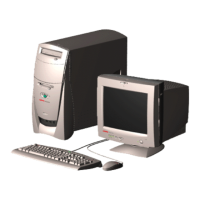PC Troubleshooting Guide 7
Troubleshooting
For solutions to problems that may occur when using
the PC, refer to the following troubleshooting pages.
Symptom describes the sign or warning message
for the type of problem.
Possible cause identifies one or more reasons
why the symptom may have occurred.
Solution describes what you should do to try to
solve the problem.
Look up the description of the symptom or problem,
and try the solution listed.
Some of the symptoms listed may not apply to your
PC. For problems relating specifically to the monitor
or printer, refer to the equipment documentation.
The tables appear in this order:
• Audio
• CD-ROM, CD-RW, DVD-ROM, or DVD Writer
Drive
• Diskette (Floppy) Drive
• Display (Monitor)
• Hard Disk Drive
• Hardware Installation
• Internet Access
• Keyboard and Mouse
• Power
• Memory
• Miscellaneous
Audio
Symptom Possible cause Solution
Volume is muted. Press the Mute button on the keyboard to see if the mute feature
is turned on.
Or
1 Click Start, and then click Control Panel.
2 Click Sounds, Speech, and Audio Devices, if it is
present, and then double-click Sounds and Audio
Devices.
3 Click the Mute check box to remove the check mark from
the box.
Volume is turned down. Use the keyboard controls to increase the volume.
Speakers are turned off. Check whether speakers are turned on.
Speaker cables are not properly
connected.
Turn off your PC, and reconnect the speakers.
PC is in standby mode. Press the Standby button (select models only), or press the Esc
key on the keyboard to resume from standby mode.
A passive speaker system is
being used.
Replace the speaker system with an active speaker system.
Active speakers have a power cord and On button and connect
to the Audio Out (green) connector on the PC.
No sound is
produced.
Headphones are plugged in. Unplug the headphones.

